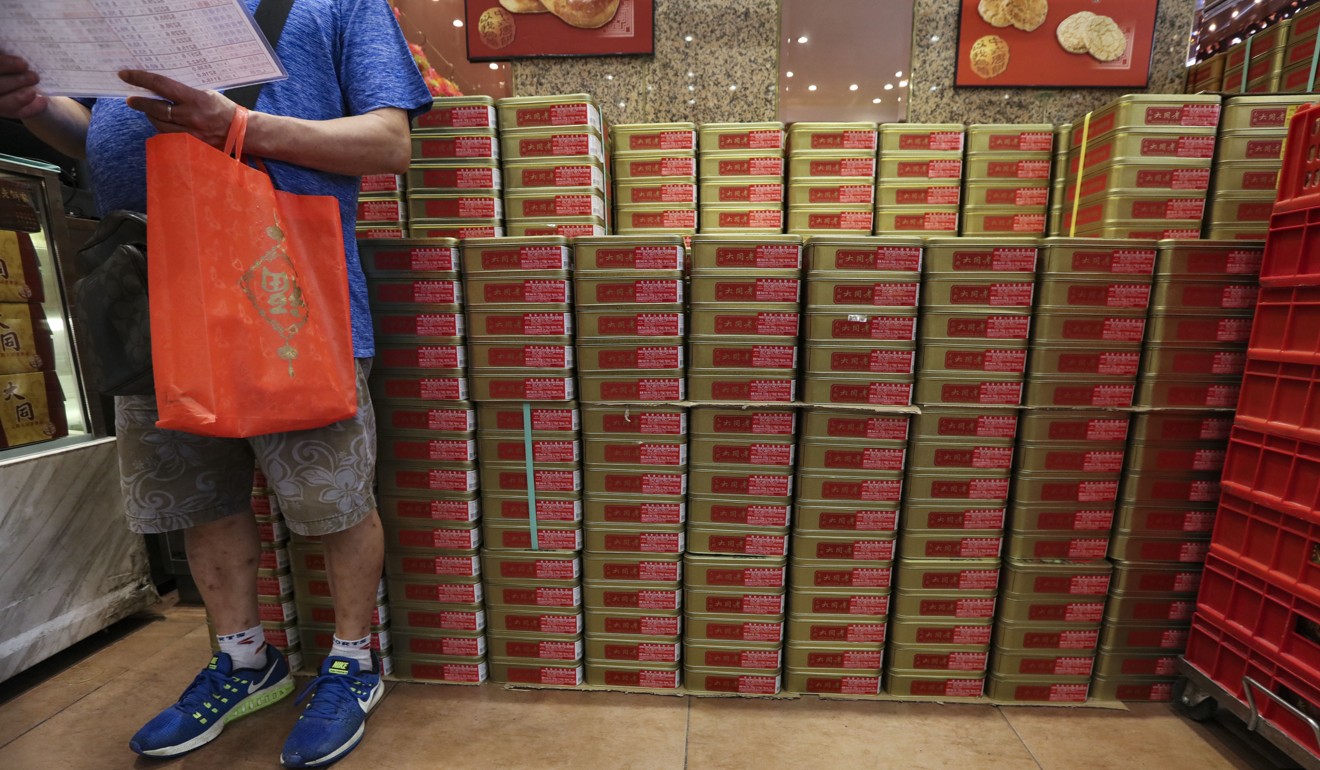
Mooncake madness descends as cross-border trade in delicacies swells
Agents buy up mooncake coupons and resell them for profit, as hungry customers struggle to get their hands on the seasonal delicacy
Hong Kong’s annual mooncake craze is already in full swing, as customers queue up for coupons for the delicacy at Maxim’s Cake stores across the city.
While coupons offered at the stores sold out in two days, resellers have inflated prices dramatically, from the initial offering price of HK$228 to about HK$330 per coupon, according to shopping agents from mainland China.
Mooncake coupons give a discount on the price of a box of mooncakes, and ensure buyers can pick up their desserts the day they first become available.
Sharon Tang, an insurance broker who has lived in the city for five years, says she has seen the coupon resale market boom in recent years.
“When you see WeChat posts about Hong Kong mooncakes five or six times a day, you start wondering: ‘why they are so [popular]?’” adds Tang, who also works as part-time buyer. “It’s all about marketing strategy.”

Tang, who is in her 20s, says she did not line up at stores or place orders online this year. Instead, she bought about 15 coupons at HK$330 each from “a friend working at a professional buying agent team”, who managed to get them even before they began selling at Maxim’s stores.
“It’s not possible to snap one up online or at the store, because there are just too many people. You need to find other ways,” Tang says, adding that she resold the coupons to friends and relatives.
And prices among the resellers continue to rocket, Tang says. “Three days ago I bought some, and yesterday when I checked, the price had risen another HK$10.”
Hong Kong’s most decadent mooncakes add opulence to Mid-Autumn Festival
Maxim’s, the local restaurant chain famous for its cakes and dim sum, produces mooncakes that are especially popular among mainland Chinese customers. A particular favourite is the lava custard mooncake: a box of six normally sells at HK$368, but with a coupon customers are entitled to a 60 per cent discount.
HKU graduate Mike Li, 23, describes the zeal of mooncake hunters as “too crazy”. Having lived in Shenzhen since graduation, Li comes to the city once a week to shop for a small group of clients he established during his college years. Like Tang, he purchases mooncake coupons from professional agents, who told him “not to bother lining up because it’s absolutely impossible to get one”.
The same agents also warned him that conflicts had broken out between locals and mainland Chinese customers. “They sent a video to our group chat recently, apparently showing a Hong Kong grandpa calling the police to complain about mainlanders snatching all the mooncakes,” Li recalls.
Hong Kong master chef shows how to make mooncakes with traditional white lotus paste filling
Li, who is ahead of the mooncake curve, bought more than 40 mooncake coupons at the lower price of HK$285, and plans to use them all to buy mooncakes for his customers, charging HK$340 per box, netting a profit of HK$55 per deal.
“A lot of people come to me after seeing online ads for Maxim’s cakes and dim sum. Most of them don’t know the original price, so they don’t have a sense of whether it’s expensive or not,” Li says.
Zephyr Liang, a university student based in Beijing, says: “I feel that more people around me are buying mooncakes from Hong Kong this year because they have developed a high reputation on social media, becoming so-called ‘web celebrity food’.”
Every year, the 22-year-old foodie orders three boxes of Maxim’s mooncakes on Taobao, Alibaba’s online shopping centre, from agents in the city. “I know some mooncakes with Hong Kong branding are actually made in mainland China, but I prefer the ones produced in Hong Kong. Somehow they just taste different,” Liang says.

“Last year there were so many fake ones, so this year some buyers even live-streamed themselves queuing up outside stores,” Liang says.
“It’s terrifying, how some retailers lie and sell fake products,” she says. “I just wish I was from Hong Kong.”
For its part, Maxim’s is predictably delighted that its products are so popular. Speaking to the Post about the situation, a spokesperson explained the apparent shortage of cakes: “the supply of our Lava Custard Mooncake is limited and it is available for sale and redemption by phases.”
Maxim’s did not respond to an inquiry from the Post about how many coupons they have sold this year so far, or how many people queued up in their stores across the city.
Hong Kong’s most creative mooncakes feature superfoods, truffle and matcha
The craving for mooncakes, however, could be problematic when it comes to maintaining a balanced diet, says nutritionist Kathy Ng Yiu-fan.
For example, a white lotus seed paste mooncake with two yolks – which commonly appears in Hong Kong households during the Mid-Autumn Festival – contains six teaspoons of oil and nearly 800 calories, Ng explains, adding that it is “almost equivalent to the entire recommended daily fat intake for a single adult”.
Ng suggests customers go for “healthier mooncakes with a lower level of fat and sugar”, such as snowy mooncakes, which only contain half the amount of fat of traditional types.

